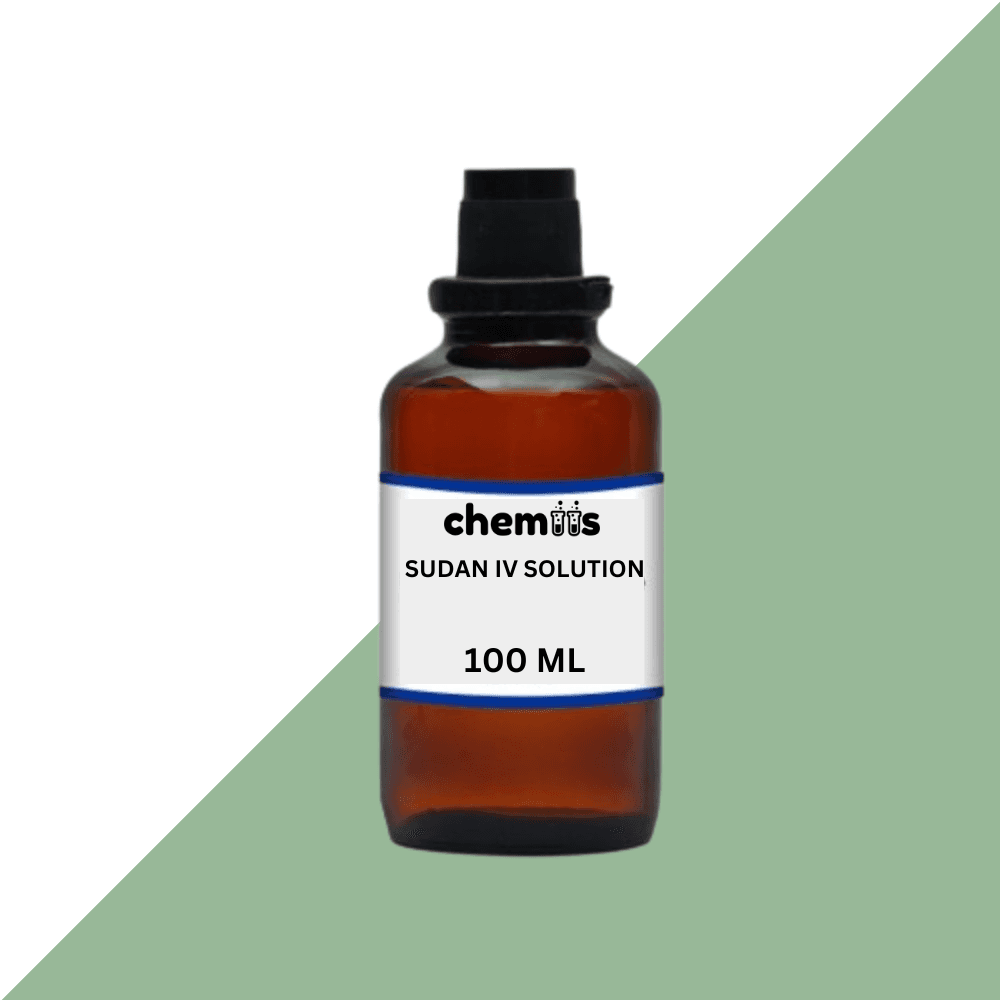Sudan IV Solution is a liquid form of Sudan IV, a synthetic red azo dye. This solution is primarily used in laboratories for staining purposes, particularly in the identification of lipids (fats) in biological tissues. The solution is a convenient, ready-to-use version of Sudan IV, which is a non-water-soluble dye. It is frequently used in histology, microbiology, and chemical analysis, providing strong, vibrant red staining to lipid-rich areas in biological samples.
Applications of Sudan IV Solution:
1. Laboratory and Research Applications:
- Lipid Staining: Sudan IV Solution is primarily used for the histological staining of lipids (fatty tissues) in biological samples. The dye binds to lipids, which allows researchers to easily identify and study lipid-rich areas under a microscope.
- Fat Detection in Tissues and Cells: It is widely used to detect fats in tissues, cells, and bacterial cultures. This application is crucial for examining diseases associated with lipid metabolism, such as obesity and metabolic disorders.
- Fat Detection in Bacteria: Sudan IV Solution is often used to stain fat globules in bacterial cells. This is particularly useful for microbial studies related to lipid content or metabolic activity.
- Triglyceride Detection in Blood: The solution can be used in biochemical assays for detecting triglyceride levels in blood samples, aiding in the diagnosis of lipid-related health conditions.
2. Diagnostic Use:
- Histopathology: Sudan IV Solution is essential in diagnostic laboratories, especially for lipid staining in histopathology slides. It helps in examining and diagnosing diseases related to lipid deposits, such as atherosclerosis and fatty liver disease.
- Analysis of Lipid Metabolism Disorders: Sudan IV Solution aids in diagnosing and researching disorders related to abnormal lipid metabolism, such as lipid storage diseases, by enabling the detection of lipids in tissues and fluids.
3. Industrial Applications:
- Textile and Plastic Dyeing: Sudan IV Solution is utilized in the textile and plastic industries as a dye for coloring fabrics and materials. Its vibrant red color makes it suitable for creating distinct, long-lasting shades in certain products.
- Oil Spill Monitoring: Sudan IV Solution is sometimes used in environmental monitoring to trace oil and other lipid substances in water samples during oil spill assessments. The solution helps highlight contamination, providing a visual indicator for further investigation.
4. Food Industry (Historical Use):
- Food Coloring (Banned in Some Countries): Sudan IV was historically used as a food colorant in certain products like chili powders and sauces, but it has been banned in many countries due to its carcinogenic properties. As a result, Sudan IV should never be used in food products.
Safety with Sudan IV Solution:
Sudan IV Solution should be handled with extreme caution due to its toxic and potentially carcinogenic properties. The following safety guidelines should be observed:
- Toxicity and Carcinogenicity: Sudan IV Solution is known to be toxic and is classified as a potential carcinogen. Prolonged exposure may lead to harmful health effects. Always use protective equipment, such as gloves, safety goggles, and lab coats when handling the solution.
- Inhalation Risk: Inhalation of vapors or fine particles from Sudan IV Solution can cause respiratory irritation. Ensure proper ventilation in the working area, such as using fume hoods or working in well-ventilated laboratories.
- Skin and Eye Contact: Direct contact with skin or eyes may cause irritation. If the solution comes in contact with the skin, wash immediately with plenty of water. If it contacts the eyes, rinse thoroughly and seek medical attention if necessary.
- Handling and Storage: Store Sudan IV Solution in a cool, dry place, away from direct light and incompatible materials. The solution should be kept in tightly sealed containers to avoid spills or contamination.
- Disposal: Dispose of Sudan IV Solution following the proper hazardous waste disposal procedures as outlined by local environmental regulations. Do not pour the solution down drains or dispose of it in regular trash.
- Spill Management: In case of a spill, avoid direct contact with the solution. Use appropriate spill kits for cleaning and safely dispose of contaminated materials.


















Reviews
Clear filtersThere are no reviews yet.